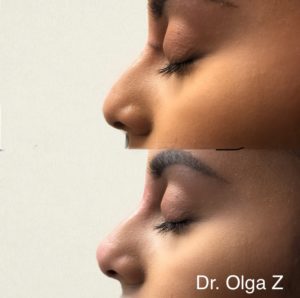Non-Surgical Nose Job Brooklyn, Long Island
Non-surgical nose job (non-surgical rhinoplasty) is performed using injectable fillers restore a more symmetric look to your nose. Controlled and precise injections can make the nose look more proportional and stright. The results are instantaneous and there is essentially no recovery, unlike surgery. The most common filler used is Radiesse®, which is made up of calcium hydroxyl appetite crystals that are very similar to the mineral found in the bones of the nose, Juvederm or Restylane – Hyaluronic acid fillers also can be used.
Although it is a welcome alternative to surgery, there are some limitations to what this approach can accomplish.
There are many ways we can reshape the nose with fillers. The most common way injectable fillers can diminish the appearance of bumps on the nose. By injecting the bridge above the bump, it makes it appear straighter. This cannot, however, make a bridge smaller, or create a gently, feminine curve in the bridge that many women desire. While this creates a straighter nose it does not make it smaller. To create a smaller nose and remove the excess bridge a rhinoplasty (nose job) surgery is required.
In other patients who have a flat nasal bridge, fillers injected to create or augment the original bridge. This is a very common request in the Asian and African American population who often have flatter noses. Unlike the situation with nasal humps as described above, this treatment can give results similar to rhinoplasty surgery, because the surgery uses either your own cartilage or a permanent implant to build the bridge instead of a temporary injection. The difference between surgery and the non-surgical approach is simply that surgery gives a permanent result that does not require repeat treatments.
The nose can be further reshaped by filling dents, hollows or indentations.
In those who have had a prior rhinoplasty surgery and have irregularities, using a filler can be a welcome alternative to undergoing a more complex revision rhinoplasty surgery. This is especially true if the imperfections after surgery are minor (like small depressions in areas around the tip and bridge) and small refinements are only necessary.
Many patients want the droopiness of their nasal tip to be lifted with injections. A droopy tip of the nose can be cause by an overactive muscle that pulls down the nasal tip called the depressor septi muscle, especially when smiling. Botulinum toxin can be injected in between the nostril on the undersurface of the nose to release this muscle and create a more upturned nose. This will usually last 3 to 5 months at a time. Fillers can be further added where the nose meets the lip to support the tip at its base. Using both of these techniques together gives the best results, but the reality is that it lifts the tip by 2 to 3 mm in the best cases which is not very much. Because of this, the non-surgical approach is best reserved for patients who only require a small amount of lifting of the tip. Those with heavy or droopier tips will usually not see a significant difference to make it worth the expense, so rhinoplasty (nose job) surgery is a better option here.

